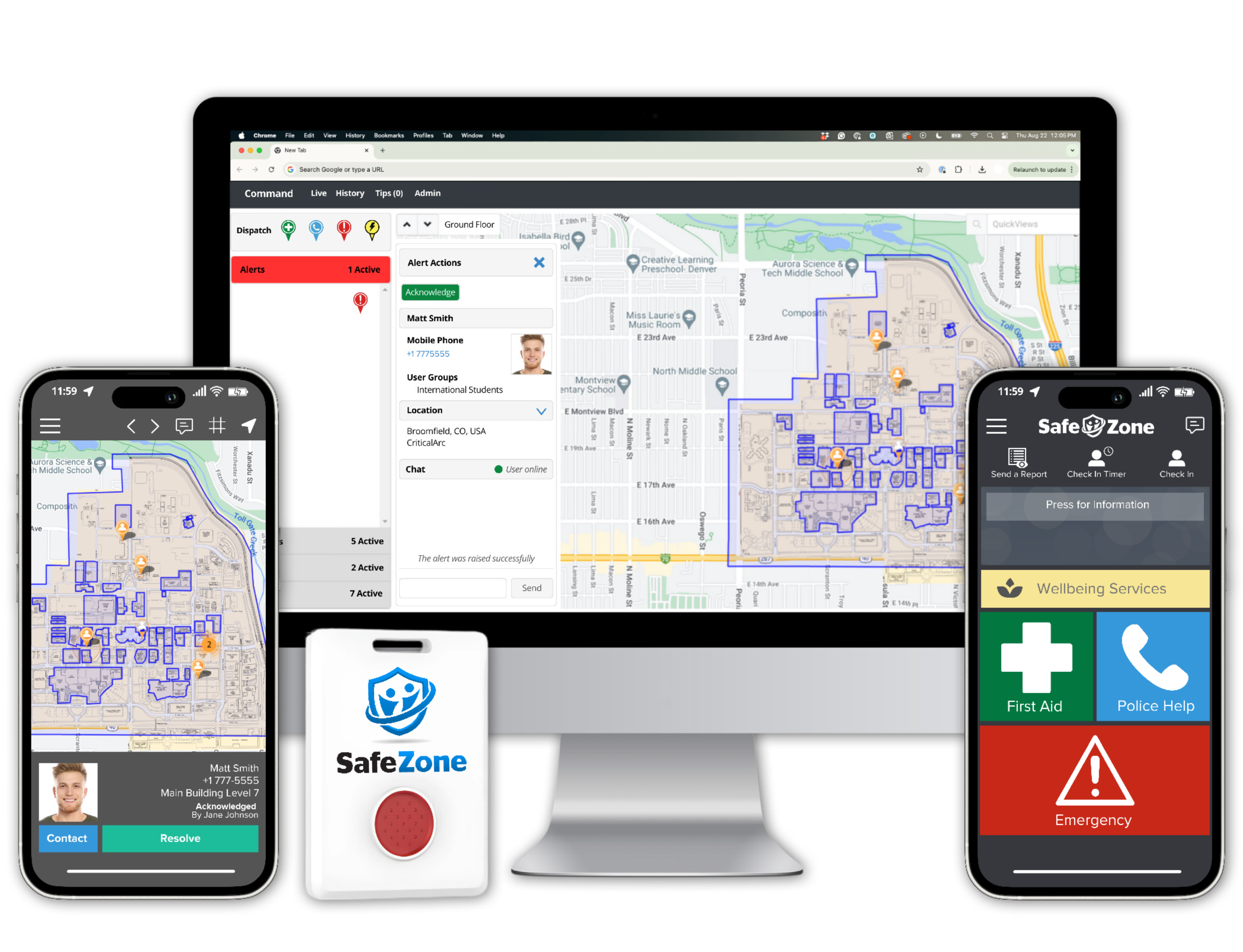 Healthcare workers hold immense trust from patients and their families, particularly in high-stress moments when loved ones urgently await updates. While aggression towards staff is never acceptable, healthcare professionals frequently highlight that insufficient communication, lack of empathy, or unclear updates can inadvertently contribute to incidents of workplace violence (WPV). Education programs emphasizing empathy, clear communication, and body language are essential tools for de-escalation. But when incidents escalate despite these efforts, real-time tools to swiftly alert responders and secure immediate assistance become critical.
Healthcare workers hold immense trust from patients and their families, particularly in high-stress moments when loved ones urgently await updates. While aggression towards staff is never acceptable, healthcare professionals frequently highlight that insufficient communication, lack of empathy, or unclear updates can inadvertently contribute to incidents of workplace violence (WPV). Education programs emphasizing empathy, clear communication, and body language are essential tools for de-escalation. But when incidents escalate despite these efforts, real-time tools to swiftly alert responders and secure immediate assistance become critical.
It’s clear that staff don’t just want conversations about safety or vague assurances; they want tangible action that demonstrates commitment. Putting SafeZone directly in the hands of staff sends a powerful message—that their personal safety matters and their organization is invested in protecting it.
Why Unified Solutions Matter
Healthcare organizations constantly face the challenge of balancing rising demands for safety with tightening budgets and stretched resources. This has made “doing more with less” a critical strategy, especially as the industry grapples with growing incidents of WPV.
The beauty of unified solutions like SafeZone lies in their efficiency and scalability. Instead of piecing together multiple systems that only cover specific areas or functions, a single, integrated platform can address safety needs across diverse environments. This means fewer gaps, less maintenance, and most importantly, more secure and confident teams.
For example, SafeZone provides tools like wearable duress alarms, mass communication capabilities, and lone worker protection all in one solution. This comprehensive approach eliminates the need for multiple vendors or costly upgrades to disconnected systems. Unified solutions streamline operations, cut down redundancy, and ensure every dollar spent on safety delivers maximum impact—not just for budgets, but for the well-being of staff too.
The Downside of Fragmented Safety Approaches
Despite frequent discussions on workplace violence, few healthcare organizations have moved beyond conversation to implement practical, impactful solutions. This gap is often evident in the fragmented approach many systems take, deploying solutions like real-time location systems (RTLS) duress alarms in isolated areas of hospitals rather than holistically across healthcare environments.
When isolated solutions are in play, important areas are left vulnerable due to limited budgets and coverage constraints. If an individual arrives at an emergency department exhibiting aggressive behavior or assaults a staff member, their care doesn’t stop there—they may proceed to wards, medical offices, or even receive care at home. Addressing security in silos not only leaves teams exposed but also strains resources by requiring separate systems for each environment.
By contrast, platforms like SafeZone enable “doing more with less” by unifying safety under one umbrella. This reduces administrative complexity and ensures every team member, from front-line hospital workers to community-based staff, benefits from the same level of protection and support.

A Cost-Conscious Approach to Comprehensive Safety
A significant example of the risks of partial deployments is investments in gun detection technology. While promising, these technologies often only cover high-traffic entrances due to budget limitations, leaving dozens of other entry points unmonitored. A recent evaluation conducted by CriticalArc’s consulting team found one U.S. hospital with as many as 75 entrances exposed, showcasing the impracticality of this patchwork approach.
Unified systems save costs by reducing the need for multiple installations, extensive ongoing maintenance, and staffing redundancies. They enable organizations to allocate resources more strategically while ensuring no critical vulnerabilities are ignored. SafeZone’s all-encompassing platform ensures budget considerations don’t come at the expense of safety for staff or patients.
The Imperative for Advanced Safety Solutions in Healthcare
Healthcare environments are inherently complex, with professionals frequently operating in high-stress situations, often in isolated or community settings. The rise in workplace violence, coupled with increasing demands on healthcare systems, calls for a shift from reactive to proactive safety solutions. Implementing advanced, integrated measures like SafeZone isn’t just an option; it’s a necessity for safeguarding both people and budgets.
A Unified Solution for Safety Everywhere™
SafeZone leads the way with a single, streamlined platform that ensures Safety Everywhere™ for healthcare organizations. Unlike traditional systems that focus on narrow functions or specific locations, SafeZone encompasses the diverse range of environments and risks healthcare professionals face daily.
How SafeZone Helps Teams Do More with Less:

- Real-Time Coordination and Response
SafeZone empowers institutions with real-time visualization and coordination tools. By replacing disjointed systems, teams can reduce response times while eliminating costly redundancies in infrastructure. - Integrated Tools for Every Scenario
SafeZone’s wearable duress alarms, lone worker check-ins, mobile integrations, and mass notification tools combine to protect staff in multiple settings without requiring additional systems. - Actionable Insights for Smarter Spending
Administrators access valuable data on incident patterns, response times, and resources, ensuring budget decisions are guided by clear, actionable insights that optimize operations. - Cost-Saving Scalability
By implementing a single platform that adapts to growth, healthcare organizations can scale protections without overwhelming their budgets or resources.
Case Study: Kent Community Health NHS Foundation Trust
The successful integration of SafeZone by Kent Community Health NHS Foundation Trust (KCHFT) offers a clear picture of what unified solutions can achieve. By replacing fragmented approaches with SafeZone, KCHFT enhanced lone worker safety, strengthened emergency coordination, and optimized their spending. Read more about KCHFT’s safety journey here.
Building Confidence and Protecting Resources
Traditional incident management often leans on scattered systems, where responders arrive too late to truly influence outcomes. SafeZone reverses this by creating opportunities for immediate intervention through seamless, real-time alerts. This proactive model prevents unnecessary escalations, saving both time and resources.
When staff see their safety being prioritized in this clear and practical way, it builds trust. They know the organization isn’t just talking about safety; they’re actively investing in it. When the tools are effective and efficient, employees feel empowered and confident that their workplace values both their peace of mind and their well-being.

A Safer Future for Healthcare
To protect teams and sustain financial health, healthcare organizations must shift to solutions that do more with less. SafeZone offers a unified, reliable way to bridge the gaps left by outdated systems, ensuring every team member receives the same high level of protection while organizations maintain control over their budgets.
When safety measures create simplicity rather than chaos, staff and patients both benefit. By championing integrated solutions with tangible impact, healthcare institutions can foster environments where everyone feels secure, supported, and able to deliver their best care.
Now is the moment to move forward with unified solutions that serve all areas of healthcare while ensuring sustainable resource management. Because at the heart of every strong system is a commitment to protecting the people who uphold it.
